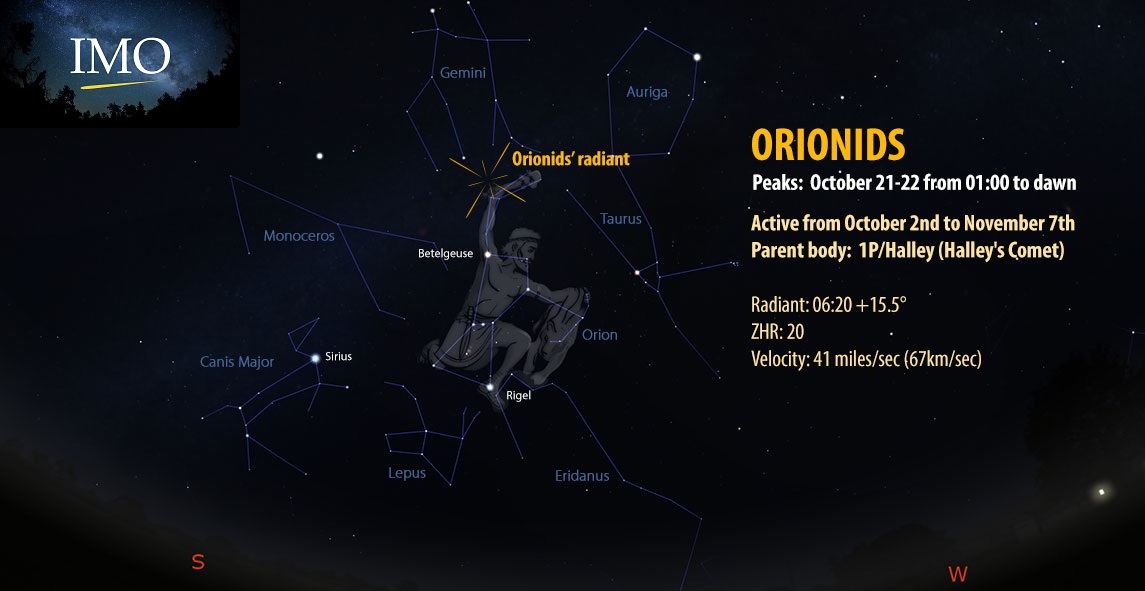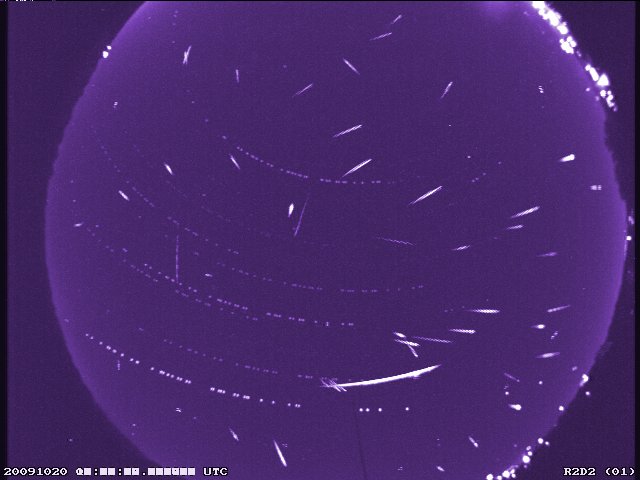Each October the Earth passes through the inbound debris of Halley’s Comet to produce the Orionid Meteor Shower. The outbound activity is seen in April and May of each year as the eta Aquariid meteor shower. Orionid activity is usually low until mid-October, when we pass closer to the core of these orbits. The Orionids are a medium strength shower, usually producing 15-20 showers members per hour at maximum as seen from dark sky locations. There have been surprises in the past when rates were three times this strong. Such strong activity is not expected this year, but only by observing this activity will we know for certain what occurs.
This year the maximum activity is predicted to occur on the morning of October 21st, when up to 20 swift Orionid meteors should be visible per hour from rural locations away from city lights. Orionid meteors are not visible until after 22:00 (10pm) local summer time as the source of these meteors does not rise above the eastern horizon until then. The best time to see these meteors is from 01:00 to dawn, when the Orionid radiant lies in excess of 30 degrees above the horizon. At the time of maximum activity the source of these meteors lies just east of the faint club of Orion. This position also lies about 10 degrees northeast of the bright orange star known as Betelgeuse (alpha Orionis). 10 degrees is equal to one’s fist with your arm held straight out.

The bright moon often interferes with viewing meteor activity by obscuring the fainter meteors. We will not encounter any such problems this year as the moon will reach its last quarter phase on October 17th and will become less of a problem with each passing night as it approaches its new phase on the 25th. On the morning of maximum activity the moon will be 15-20 percent illuminated and far to the east of the radiant. If you find the crescent moon distracting you can always change directions you are facing so that it will not lie within your field of view. With the moon out of the way the only things that would stop you from seeing the show would be clouds and bright city lights. There is not much can do about cloud cover other than checking at later times during the morning. If the entire night is lost to clouds you can try again on the next night as Orionid activity will be almost as strong on the night of October 21/22. In fact the Orionids are strong for several night surrounding October 21st, so if the night of maximum is predicted to be cloudy, you can still witness good rates just before and after the maximum. As for bright city lights, it is highly recommended that you find a safe rural observing spot away from city lights as the more stars you can see, the more meteors you will count.
The best way to see these meteors is to lie in a comfortable lounge chair with the back angled so that you are looking about half-way up in the sky. You can look straight up if your sky near the horizon is brightly lit, but more meteors are seen in the lower half of the sky than straight up as you are looking through a much thicker column of the atmosphere. I would recommend facing due south so that you can also distinguish minor meteor activity that is coming from Taurus, Gemini, and Leo Minor. Taurid meteors would be slower than the Orionids while those from Gemini and Leo Minor would also be swift, like the Orionids. These minor showers usually only produce about 2 meteors per hour at best. There are also random meteors that do not belong to any recognizable source. On October mornings these random meteors normally usually number about 10 per hour. One bonus this year is that we are expecting more fireball activity from the Taurids this year. So also be on the lookout for bright, slow moving meteors from an area west of Orion near the constellations of Aries and Taurus. It should be mentioned that the Orionids and the other minor showers are all visible from the Southern Hemisphere, but at lower elevations in their northern sky.

Viewing meteor activity is a great way to easily contribute to science by being a citizen scientist. In order to produce scientifically useful data you need to view for at least one hour and provide shower associations with each meteor you witness. It also is necessary to provide us with the magnitude of the faintest star you can see. This is easily done by counting the number of stars visible with certain areas of the sky – see also https://www.imo.net/observations/methods/visual-observation/ and here for more tips on viewing meteor showers. In order to share your observations it is suggest that you to fill out a visual meteor report form from the International Meteor Organization. This is only available to registered members, but this option is free to those who just wish to contribute data. We strongly encourage everyone to join the IMO as a full member as detailed analysis of the Orionids and others meteors showers is presented in the IMO Journal.
We wish you good luck and look forward to seeing your viewing results!




 You saw something bright and fast? Like a huge shooting star? Report it: it may be a fireball.
You saw something bright and fast? Like a huge shooting star? Report it: it may be a fireball.  You counted meteors last night? Share your results with us!
You counted meteors last night? Share your results with us!  You took a photo of a meteor or fireball? You have a screenshot of your cam? Share it with us!
You took a photo of a meteor or fireball? You have a screenshot of your cam? Share it with us!  You caught a meteor or fireball on video? Share your video with us!
You caught a meteor or fireball on video? Share your video with us!